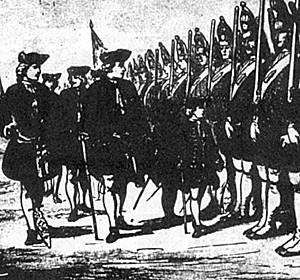 By drill, strict discipline, field training and war Frederick
the Great turned the Prussian Army into one of the most outstanding
forces the world had known, renowned for its great ability to march, to
react to orders and to keep itself efficiently in the field. Not since Roman
times had soldiers spent so much time practicing in peace what they
were to do in battle, resulting in perfection of movement through a
system of iron discipline.
By drill, strict discipline, field training and war Frederick
the Great turned the Prussian Army into one of the most outstanding
forces the world had known, renowned for its great ability to march, to
react to orders and to keep itself efficiently in the field. Not since Roman
times had soldiers spent so much time practicing in peace what they
were to do in battle, resulting in perfection of movement through a
system of iron discipline.
Frederick had his cavalry units trained to fight two ranks deep, in squadrons of about 120 troopers; their charges were made at the full gallop with the men precisely spaced. The example of Gustavus Adolphus in keeping his artillery up with the rest of the army was followed by Frederick whose artillery was said to be able to produce a rapid fire from 9-pounder field guns while advancing. His 3-pounders were assigned to individual battalions.
The Prussian infantry battalions were divided into eight companies and arrayed three deep; they fired volleys with all three ranks of an entire company firing together and then loading in unison. Simultaneously, other companies would be doing the same to a different timing, so that companydischarges at an average rate of one every two seconds or faster was the practice. Frederick's infantry, through their drill, could fire volleys at moderate ranges to disorganise their opponents and still charge with loaded bayonet-fixed muskets immediately after.
Under its great warrior King, the Prussian Army appears to have had no serious weaknesses. Superlative training and the great co- operation between infantry and artillery with cavalry possessing enormous shock potential, made them the model for Europe. During the Seven Years War (1756 to 1763) Frederick's epic struggle against the combined forces of Austria, France, Russia, Saxony and Sweden gained for his country an important place among European nations.
Back to Table of Contents -- Wargamer's Newsletter # 155
To Wargamer's Newsletter List of Issues
To MagWeb Master Magazine List
© Copyright 1975 by Donald Featherstone.
This article appears in MagWeb (Magazine Web) on the Internet World Wide Web.
Other military history articles and gaming articles are available at http://www.magweb.com